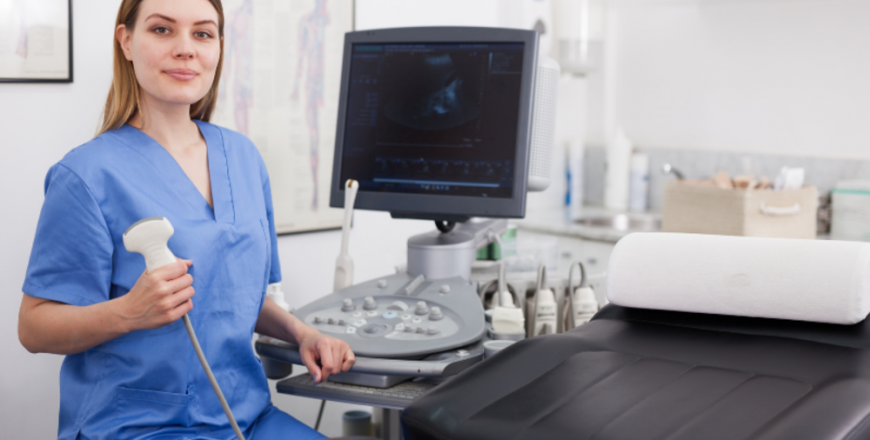
On a sonographer apprenticeship course, you’ll help perform and report various diagnostic and screening ultrasound examinations.
In hospitals and clinics, a sonographer conducts diagnostic and screening ultrasound scans. Ultrasound uses highly specialised scanning equipment to create echoes of high-frequency sound waves that may be reflected off biological tissues. The echoes are then converted into an image called a sonogram. Ultrasound imaging gives an inside view of soft tissues and the body, enabling anatomy to be investigated and anomalies to be recognised.
As a sonographer, you will learn how to perform and report on a wide range of clinical ultrasound tests within a specialised practice area. Cancer detection, women’s health and pregnancy, abdominal, and vascular and musculoskeletal checks may be among them, depending on your scope of practice.
The job requires excellent hand-eye coordination, spatial awareness, and interpersonal abilities. You often report to advanced practitioners and may oversee healthcare assistants and clinical support staff.
What you’ll learn
On a sonographer apprenticeship course, you’ll learn to:
- Accept and verify recommendations, and advise other healthcare experts on the utility and application of ultrasound testing to the needs of service consumers.
- Use independent procedures to verify and authenticate service user identity and patient authorisation before ultrasonography operations.
- Assess the patient’s clinical state before, during, and after ultrasound examinations, recognising changing signs, symptoms, and illness progression, and making suitable judgements about ultrasound appearances and the patient’s urgent care.
- Use effective communication with the patient before and throughout the evaluation to determine their suitability for the operation.
- Assess communication barriers and change communication to create inclusivity, connection, and rapport with all patients.
- Acquire, interpret, and report on a broad range of ultrasound tests in their practice field with skill and accuracy.
- Optimise the ultrasound equipment and settings to provide a high-quality scan.
- Use spatial awareness and psychomotor ability while moving the patient’s body to generate accurate ultrasound images.
- Distinguish between normal and abnormal appearances seen during the ultrasound examination and on the following ultrasound images, and summarise findings in a written report.
- Examine ultrasound images’ clinical symptoms and technical validity concerning their diagnostic use.
- Work both alone and as part of a multi-professional team.
- Operate ultrasound equipment and related auxiliary equipment safely and accurately, and take the required precautions in the case of poor functioning and operation.
- Apply the risk-benefit principle to ultrasonic safety problems to protect individual service users and the public.
- Accept responsibility for making informed decisions while carrying out a broad range of clinical, technical, management, or scientific activities, and maintain correct records.
- Recognise verbal and nonverbal cues that the patient may need emotional and psychological help.
- Seek expert supervision to ensure help while dealing with potentially distressing and challenging circumstances.
- Utilise various cognitive and practical ultrasonography talents to initiate solutions to ultrasound difficulties.
- Manage risk, express safety concerns, and be open and honest when things go wrong.
- Maintain accurate records of one’s work while also promoting and protecting the interests of patients, staff, and the broader public.
- Maintain and protect patient confidentiality while following local and national safeguarding policies and standards.
- Recognise and respond appropriately when information sharing is essential to safeguard ultrasound patients or the broader public.
- Manage one’s workload and resources wisely, and practise as needed.
- Integrate theoretical and practical knowledge to overcome problems.
- Work within your expertise and skills, and delegate appropriately. Lead and manage per your level of responsibility.
- Maintain and enhance your skills and knowledge.
- Contribute to developing, planning, and implementing clinical audit and service improvement initiatives and review and develop personal clinical practice based on evidence-based research and clinical trial outcomes.
- Collaborate with service consumers, other professionals, support personnel, and others to complete tasks as part of a multidisciplinary team.
- Consider ultrasound practice and current evidence critically, and use critical thinking and problem-solving in professional decision-making.
- Use conflict resolution strategies.
- Keep accurate, complete, and intelligible records and other information under applicable laws, rules, and standards.
- Consider and learn from clinical episodes and concerns, and communicate what you’ve discovered with your colleagues.
- Use information and communication technologies for their profession.
- Use basic life-support measures and be able to handle clinical circumstances safely.
Entry requirements
You’ll usually need:
- Five GCSEs, including English and maths, and three A-levels, including one science; or equivalent qualifications.
- Apprentices without level 2 English and maths will need to achieve this before taking the end-point assessment.
Assessment methods
The End Point Assessment comprises two distinct assessment methods:
- Demonstration of practice with question-and-answer session
- Professional Discussion
Restrictions and requirements
You’ll need to:
Duration, level, subjects and potential salary upon completion
- Duration: 36 months
-
Level: 6 – Degree Apprenticeship
- Relevant school subjects: Science
- Potential salary upon completion: £42,000
Apprenticeship standard
More information about the Level 6 Sonographer Apprenticeship standard can be found here.
Apprenticeship end point assessment
For more information about the End Point Assessment Process, please read the Institute of Apprenticeships’ information page
